New selectivities from old catalysts. Occlusion of Grubbs’ catalysts in
Ethylene Oxide Formation in a Microreactor From Qualitative Kinetics to Detailed Modeling
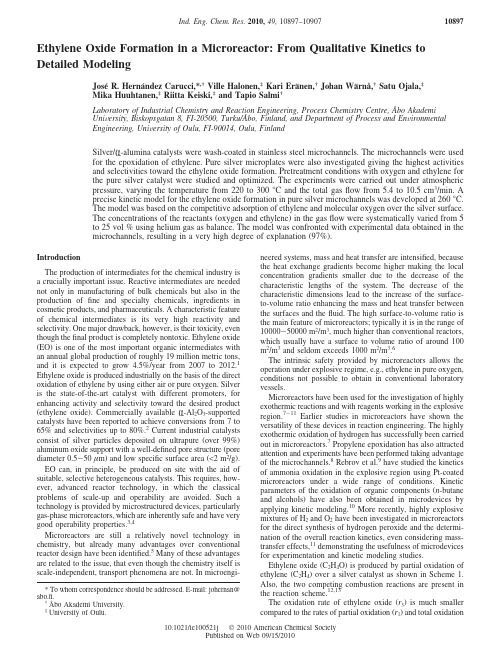
Ethylene Oxide Formation in a Microreactor:From Qualitative Kinetics to Detailed ModelingJose´R.Herna´ndez Carucci,*,†Ville Halonen,‡Kari Era¨nen,†Johan Wa¨rnå,†Satu Ojala,‡Mika Huuhtanen,‡Riitta Keiski,‡and Tapio Salmi†Laboratory of Industrial Chemistry and Reaction Engineering,Process Chemistry Centre,Åbo AkademiUni V ersity,Biskopsgatan8,FI-20500,Turku/Åbo,Finland,and Department of Process and En V ironmentalEngineering,Uni V ersity of Oulu,FI-90014,Oulu,FinlandSilver/R-alumina catalysts were wash-coated in stainless steel microchannels.The microchannels were usedfor the epoxidation of ethylene.Pure silver microplates were also investigated giving the highest activitiesand selectivities toward the ethylene oxide formation.Pretreatment conditions with oxygen and ethylene forthe pure silver catalyst were studied and optimized.The experiments were carried out under atmosphericpressure,varying the temperature from220to300°C and the total gasflow from5.4to10.5cm3/min.Aprecise kinetic model for the ethylene oxide formation in pure silver microchannels was developed at260°C.The model was based on the competitive adsorption of ethylene and molecular oxygen over the silver surface.The concentrations of the reactants(oxygen and ethylene)in the gasflow were systematically varied from5to25vol%using helium gas as balance.The model was confronted with experimental data obtained in themicrochannels,resulting in a very high degree of explanation(97%).IntroductionThe production of intermediates for the chemical industry is a crucially important issue.Reactive intermediates are needed not only in manufacturing of bulk chemicals but also in the production offine and specialty chemicals,ingredients in cosmetic products,and pharmaceuticals.A characteristic feature of chemical intermediates is its very high reactivity and selectivity.One major drawback,however,is their toxicity,even though thefinal product is completely nontoxic.Ethylene oxide (EO)is one of the most important organic intermediates with an annual global production of roughly19million metric tons, and it is expected to grow4.5%/year from2007to2012.1 Ethylene oxide is produced industrially on the basis of the direct oxidation of ethylene by using either air or pure oxygen.Silver is the state-of-the-art catalyst with different promoters,for enhancing activity and selectivity toward the desired product (ethylene oxide).Commercially available R-Al2O3-supported catalysts have been reported to achieve conversions from7to 65%and selectivities up to80%.2Current industrial catalysts consist of silver particles deposited on ultrapure(over99%) aluminum oxide support with a well-defined pore structure(pore diameter0.5-50µm)and low specific surface area(<2m2/g). EO can,in principle,be produced on site with the aid of suitable,selective heterogeneous catalysts.This requires,how-ever,advanced reactor technology,in which the classical problems of scale-up and operability are avoided.Such a technology is provided by microstructured devices,particularly gas-phase microreactors,which are inherently safe and have very good operability properties.3,4Microreactors are still a relatively novel technology in chemistry,but already many advantages over conventional reactor design have been identified.5Many of these advantages are related to the issue,that even though the chemistry itself is scale-independent,transport phenomena are not.In microengi-neered systems,mass and heat transfer are intensified,because the heat exchange gradients become higher making the local concentration gradients smaller due to the decrease of the characteristic lengths of the system.The decrease of the characteristic dimensions lead to the increase of the surface-to-volume ratio enhancing the mass and heat transfer between the surfaces and thefluid.The high surface-to-volume ratio is the main feature of microreactors;typically it is in the range of 10000-50000m2/m3,much higher than conventional reactors, which usually have a surface to volume ratio of around100 m2/m3and seldom exceeds1000m2/m3.6The intrinsic safety provided by microreactors allows the operation under explosive regime,e.g.,ethylene in pure oxygen, conditions not possible to obtain in conventional laboratory vessels.Microreactors have been used for the investigation of highly exothermic reactions and with reagents working in the explosive region.7-11Earlier studies in microreactors have shown the versatility of these devices in reaction engineering.The highly exothermic oxidation of hydrogen has successfully been carried out in microreactors.7Propylene epoxidation has also attracted attention and experiments have been performed taking advantage of the microchannels.8Rebrov et al.9have studied the kinetics of ammonia oxidation in the explosive region using Pt-coated microreactors under a wide range of conditions.Kinetic parameters of the oxidation of organic components(n-butane and alcohols)have also been obtained in microdevices by applying kinetic modeling.10More recently,highly explosive mixtures of H2and O2have been investigated in microreactors for the direct synthesis of hydrogen peroxide and the determi-nation of the overall reaction kinetics,even considering mass-transfer effects,11demonstrating the usefulness of microdevices for experimentation and kinetic modeling studies.Ethylene oxide(C2H4O)is produced by partial oxidation of ethylene(C2H4)over a silver catalyst as shown in Scheme1. Also,the two competing combustion reactions are present in the reaction scheme.12,13The oxidation rate of ethylene oxide(r3)is much smaller compared to the rates of partial oxidation(r1)and total oxidation*To whom correspondence should be addressed.E-mail:johernan@abo.fi.†Åbo Akademi University.‡University of Oulu.Ind.Eng.Chem.Res.2010,49,10897–109071089710.1021/ie100521j 2010American Chemical SocietyPublished on Web09/15/2010(r 2)of ethylene;hence,the reaction scheme is generally considered to be parallel.All the reactions are highly exothermic:∆H )-105kJ/mol for r 1,-1323kJ/mol for r 2and -1218kJ/mol for r 3.14The heat generated from the total oxidation reactions is much higher than the heat produced by the partial oxidation reaction.Thus,the chemical equilibrium strongly favors the formation of the total oxidation products,and the reason why ethylene oxide is not oxidized further is purely kinetic.15The total heat of reaction in a conventional industrial reactor reaches -350to -550kJ/mol,causing “hot spots”and heat removal problems.16The involved reactions in the ethylene oxidation range from mildly exothermal (partial oxidation)to strongly exothermal (complete oxidation).In that sense,it is required to quench the reactor as fast as possible to avoid problems with selectivity.Microreactors,because of their very high surface-to-volume ratio,permit an efficient removal of the produced heat,avoiding unwanted temperature gradients inside the microchannels.The mechanism of the ethylene oxidation over silver catalysts has been studied by many researchers,and there is extensive open literature available on the subject.17Several different reactor systems,operation conditions,and various catalysts with varying concentrations of silver and additives have been used.However,despite extensive studies by both experimental andtheoretical methods the reaction mechanism remains contro-versial.15Furthermore,although a lot of research has been done on catalytic gas-phase processes in microdevices,kinetic model-ing is often missing.In this work,we present a systematic approach to a very precise kinetic modeling of ethylene oxide production data obtained from a stainless steel microreactor.Experimental SectionEquipment.A stainless steel microreactor purchased from Institut fu ¨r Mikrotechnik Mainz GmbH (IMM)was used for the synthesis of EO.The reactor consists of two parts:the top and the housing.Figure 1,left,shows the top part where 10catalyst and 10mixer plates are stacked.The lower part of the chamber has two recesses,each filled with a stack of 10stainless steel or silver microstructured plates,which are connected by a diffusion tunnel,with a 1mm length and an approximate volume of 52.8mm 3,where the gases from the two reactor inlets mix before entering into the catalytic area (Figure 1,right).The first stack contains a total of 10mixing plates with nine semicircular channels of different radii but with a common center.They are arranged in the stack in such a way that they meet the two inlets in alternation.The second stack,the catalytic zone of the reactor consists of 10rectangular plates with nine parallel shallow microchannels each (total of 90microchannels:i.d.)460µm,length )9.5mm,and depth )75µm)coated with an Ag/Al 2O 3catalyst or made by pure silver.Figure 2shows a scheme of the plates’configuration inside the microreactor.The reactor housing is made of Inconel 600(2.4816)and 1.4571for the mixing and catalytic plates.The reactor is sealed with graphite gaskets and tightened with six screws.The inlet gas concentrations were regulated by using four mass flow controllers (MFC):0-3cm 3/min Brooks 5850S for ethylene,0-3cm 3/min Brooks 5850E for oxygen,and two 0-20cm 3/min Brooks 5850S for helium.The mass flow controllers were previously calibrated to each gas by using aScheme 1.Reaction Stoichiometry of Partial and TotalOxidation of Ethylene and Total Oxidation of Ethylene Oxide over Silver Catalyst13Figure 1.Top part of the microreactor with one catalytic and one mixing plate (left)and microreactor housing(right).Figure 2.Scheme of the reactor configuration (10stacked microplates,catalytic zone).10898Ind.Eng.Chem.Res.,Vol.49,No.21,2010Humonics 520digital flowmeter.The scheme of the system used for the catalytic experiments with the stainless steel microreactor (MR)is presented in Figure 3.The temperature of the microreactor was regulated by external heating cartridges controlled by a CAL9500temperature controller.K-type thermocouples (chromel -alumel)were used for temperature measurements/control.The temperature was measured in the top part of the microreactor (Figure 1,left)behind the catalytic zone.Due to the small dimensions of the device,and given its high heat-transfer capabilities,this tem-perature was assumed to be identical as the temperature in the microchannels.After the microreactor,the effluent gases were analyzed by Agilent 3000A Micro GC with four independent columns (PLOT U for identifying carbon dioxide,OV-1for ethylene oxide,alumina for ethylene,and Molsieve 5A for measuring oxygen concentrations)and TC detectors.The gases used in the preparation of ethylene oxide were scientific ethylene (99.95%,Linde Gas)and instrument oxygen (99.999%,AGA).Helium (99.996%)was used as carrier gas.For the kinetic experiments,the temperature was kept at 260°C and the total flow was set to 6cm 3/min with concentrations of oxygen and ethylene varying from 5to 25vol %.Different channel widths are assumed to provide a constant volume flow through all channels,regardless of their length.18The kinetic measurements were done 18min after both ethylene and oxygen were fed to the microreactor.Catalyst Preparation.A silver/R -alumina catalyst was prepared by thermally decomposing ground γ-alumina (A300LaRoche Industries Inc.)for 12.5h at 1500°C.The incipient wetness method was used for further impregnating the obtained R -alumina powder.A 3.786g amount of silver nitrate (99.8%,Merck)was dissolved in 5g of deionized (DI)water.A 13.354g amount of R -alumina was further mixed slowly into the solution.The obtained suspension was thoroughly mixed for 30min and placed to dry overnight at 60°C.The powder was further dried at 100°C for 2h and then calcined at 650°C for 3h.Before the deposition of the wash coat,the catalyst plates of the microreactor were cleaned from impurities by using the method described by Howell and Hatalis.19First,the plates were immersed in acetone for 5min and rinsed with deionized water.They were further immersed in a solution of 5:1:1DI water,hydrogen peroxide (29-32%,Merck),and ammonium hydrox-ide (32%,Sigma-Aldrich)for 5min and rinsed with DI water.Finally,the plates were immersed in a solution of 5:1:1:1DIwater,hydrogen peroxide (29-32%,Merck),phosphoric acid (85%,FF-Chemicals),and acetic acid (99%glacial,J.T.Baker)in an ultrasonic bath for 5min,rinsed with DI water,and then dried.The catalyst was then wash-coated in the microplates as described in Stefanescu et al.20A suspension of 77wt %of DI water,5wt %of acrylic acid (99%,Fluka Chemika),2wt %of acetic acid,and 16wt %of catalyst powder was prepared.Water and acids were mixed at first,followed by the powder.The suspension was kept under stirring for 24h at room temperature,before deposition.The microplates were calcined in air at 800°C for 2h prior to the wash-coating procedure.The suspension was applied to the microchannels of the plates by a syringe,and the excess suspension was wiped off.The plates were dried at 100°C for 2h and calcined at 650°C for 3h.Pure silver plates obtained from IMM were also evaluated for the chemical synthesis.The plates were made from pure polycrystalline silver,having the same dimensions as the catalyst plates made from stainless steel described above.Catalyst Characterization Methods.The surface areas of the alumina supports and impregnated catalyst powders were measured with a sorptometer (Carlo Erba Instruments Sorp-tomatic 1900),by nitrogen physisorption.The total surface area was obtained by using the Brunauer -Emmett -Teller (BET)equation.Additionally,scanning electron microscope images were taken from the plates,and the elemental composition was analyzed by energy dispersive X-ray spectroscopy (EDS).The SEM device used was Leo Gemini 1530manufactured by Zeiss with an energy dispersive X-ray detector (ThermoNONAN Vantage,120kV).Results and DiscussionCatalyst Characterization Results.Specific surface area measurements,SEM images,and elemental composition from SEM-EDS analysis were used to characterize the synthesized catalysts.Specific surface area measurements were taken from the resulting R -Al 2O 3supports,obtaining a value of 3.7m 2/g.After impregnation with silver,the surface area remained unchanged.The elemental composition of the prepared catalyst was analyzed by SEM-EDS.The silver loading with respect to alumina was found to be 15wt %,while the nominal loading was aimed to 18wt %.A SEM image of thecatalystFigure 3.Scheme of the system used.Ind.Eng.Chem.Res.,Vol.49,No.21,201010899(magnification,1000×)is shown in Figure 4,where the brighter silver clusters can be clearly seen on the alumina support.The thickness of the catalyst layer was also estimated from the SEM micrographs.According to Stefanescu et al.,20the thickness of the coatings should be in the range of 20-25µm.Figure 5shows the profile of the microplate at 35×magnifica-tion.The coating of the catalyst in the microchannels resulted in a uniform distribution,as shown by SEM imaging (Figure 6).The catalytic layer thickness was determined to be between 15and 20µm,results that are in agreement with previous findings.20Activity Evaluation.Ag/r -Al 2O 3.The first set of experiments was conducted with the 15wt %Ag/R -Al 2O 3catalyst.The reactor was assumed to operate at constant temperatures.The high surface-to-volume ratio present in the microreactor permits an efficient heat transfer,allowing the operation at isothermal conditions even with highly exothermic reactions.Furthermore,due to the low conversion levels obtained in this work,the reaction heat produced would not effectively raise the temper-ature of the reactor.Low ethylene conversion and selectivity toward ethylene oxide was observed without previous catalytic treatment (0.28and 14%at 300°C,respectively).OnlyatFigure 4.SEM image of the prepared Ag/Al 2O 3catalysts.The bright spots were identified as silver by SEM-EDS analysis,magnification 1000×.Figure 5.Profile of one Ag/Al 2O 3coated plate.10900Ind.Eng.Chem.Res.,Vol.49,No.21,2010temperatures higher than 280°C,ethylene oxide could be analytically detected when high concentrations of ethylene were fed (20vol %).Additionally,to check the reproducibility of the experiments,every fifth experiment was conducted in the following conditions:20vol %ethylene and 10vol %oxygen with a total flow of 6cm 3/min and a temperature of 280°C.Nault et al.21tried pretreating the catalyst with oxygen,ethylene,hydrogen,and ethylene oxide in order to improve the stability and activity of the catalyst.A similar approach of different pretreatments with oxygen and ethylene was tested in this study,in order to find good stability and activity windows for the catalyst.For the oxidation/reduction pretreatment the catalyst was first exposed to 20vol %oxygen for 15min at 300°C and a total flow of 5.4cm 3/min,followed by a helium flow for 10min.The microplates were further treated with 20vol %ethylene for 15min at 300°C,with a total flow of 5.4cm 3/min.Prior to the experiment,the microreactor was purged with helium for 10min.This procedure was inverted for the reduction/oxidation pretreatment.The oxygen/ethylene pretreatment gave better initial conver-sion and selectivity toward ethylene oxide formation.According to Nault et al.,21this behavior could be explained by the extra ethylene adsorbed on the catalyst.The activity decreased rapidly at the beginning (conversion of ethylene from 0.67to 0.43%).After 18min of reaction,the activity continued to decrease steadily.With the reduction/oxidation pretreatment,the catalyst kept a stable activity (conversion of ethylene,0.31-0.33%),but the conversion was lower than with the oxidation/reduction pretreatment.The selectivity toward ethylene oxide had a similar trend:for oxygen/ethylene pretreatment the selectivity decreased from 15.5to 12.5%over 27min,while for ethylene/oxygen pretreatment it fluctuated between 10.6and 11.1%(Figure 7).Additionally,experiments with longer times-on-stream were performed over the studied catalysts.The experiments showed a very stable behavior after 24h of operation where both conversion and selectivities remained very much constant (results not shown).The conversion levels obtained in this work were clearly lower than conventional reactors,although selectivity levels were comparable.In the absence of any promoter,the reaction of ethylene and oxygen over silver catalysts produces ethylene oxide at about 50%selectivity while,with Cl and Cs promoters,levels of 80%in selectivity have been found.22,23However,the experiments carried out in this study were performed at atmospheric pressure,whereas,conventionally,the pressures can go up to 30bar.Higher conversions might still be achieved byobvious approaches,i.e.,increasing the pressure,increasing the residence time inside the microchannels,and increasing the thickness of the wash coats.Nonetheless,for a pure kinetic study,low conversions are required in order to neglect the concentration gradient over the axial reactor coordinate.Moreover,the conversion issue could be resolved by scaling-out (numbering-up)the microreactors to build a network as suggested in the literature.24The microreactor network should be constructed in a way that allows the macrosystem to operate under conditions similar to each elementary microchannel.However,numbering-up or scaling-out of the microstructure reactor is not straightforward and could present problems when operating at macroscopic flow rates.Numbering-up of microre-actors might result in a large flow maldistribution broadening and shifting the reactants residence time curve.25Additionally,higher conversions might also increase the risk of explosion in the downstream equipment and a need of purification and separation would be needed.The catalytic activity seemed to be diminished by the oxidation,probably due to adsorbed molecular oxygen on the catalytic surface and not reacting with ethylene.Nonetheless,it occupies catalytic sites diminishing the space available on the surface.Figure 7shows that conversion,as well as selectivity with oxygen/ethylene pretreatment would eventually reach the same level as the one obtained with the ethylene/oxygen pretreatment (conversion of ethylene ca.0.33%andselectivityFigure 6.SEM images of an Ag/Al 2O 3-coatedmicroplate.Figure 7.Effect of pretreatment with oxygen and ethylene on conversion (filled symbols)and selectivity (open symbols)on Ag/alumina wash-coated microchannels.Oxygen/ethylene pretreatment:20vol %O 2for 15min plus 20vol %C 2H 4for 15min at 300°C;total flow of 6cm 3/min (-b -).Ethylene/oxygen pretreatment,inverse order (-9-).Reaction conditions:20vol %ethylene,10vol %oxygen,and a total flow of 6cm 3/min at 300°C.Ind.Eng.Chem.Res.,Vol.49,No.21,201010901toward ethylene oxide ca.11%).It was determined that only the last component used for pretreatment (either ethylene or oxygen alone)was sufficient for determining the catalytic activity.It was concluded from these experiments that pretreat-ment with ethylene would be beneficial for achieving better conversions and selectivities toward ethylene oxide.Basically,the second step of the pretreatment (oxidation in the reduction/oxidation or reduction in the oxidation/reduction)was the one affecting the reaction.In that sense,an experiment with only oxidizing pretreatment gave the same results as the reduction/oxidation pretreatment.The same was true for the case of only reducing of the oxidation/reduction pretreatment.It seems that either oxygen or ethylene was able to rapidly desorb from the silver surface when the microplates were further treated with helium.Figure 8illustrates the influence of the total flow on the conversion of ethylene and selectivity to ethylene oxide.As the total flow increased from 6to 10.5cm 3/min,the residence time decreased from 0.101to 0.058s inside the microreactor,causing a conversion reduction from 0.15to 0.07%.The selectivity toward ethylene oxide remained more or less stable,varying slightly from 19.5to 22%.The yield of ethylene oxide decreased vaguely from 0.03to 0.02%,while the total flow increases from 6to 10.5cm 3/min.The effect of temperature on conversion and selectivity is shown in Figure 9.The measurements were taken 18min after introducing both reactant gases (ethylene and oxygen).The conversion of ethylene to ethylene oxide increased rapidly from0.03to 0.28%,as the temperature increased from 220to 300°C.The yield of ethylene oxide showed a similar behavior.The selectivity toward ethylene oxide decreased linearly from 29to 14%at the same temperature range.As expected,the total oxidation reaction became more dominant at higher temperature.Pure Silver Plates.For the case of pure silver plates,similar pretreatment conditions were used.Figure 10shows the effect of pretreatment over the pure silver microplates.When pre-treating with ethylene,a 20vol %flow was kept for 20min at 260°C with a total flow of 5.4cm 3/min.As oxygen was used as pretreatment gas,the parameters were kept identical.Before starting the experiment,the microreactor was purged with helium for 20min in both cases.A peak of ethylene oxide formation was observed after 6min after beginning the reaction,together with a slight decrease in the selectivity (Figure 10)when the silver plates were treated with ethylene.Because oxygen was used as a pretreatment gas,the conver-sion was gradually increasing from 0.05to 0.08%after 18min of reaction,while the selectivity toward ethylene oxide changed from 25.9to 38.7%.An important difference between the pretreatments was noticed since the conversion for ethylene-treated catalyst resulted in almost twice the conversion of oxygen-treated microplates.Similar trends of catalytic behavior were observed by Nault et al.in their study.21They treated first the catalyst overnight with pure oxygen at 200°C and followed it with an ethylene treatment.They noticed that,after an initial activity peak,the catalyst slowly decreased its activity,stabilizing only after 2h.Additionally,the treatment of the catalyst with hydrogen and consecutively with ethylene resulted in a further enhancement of the activity.21They presented the possibility that the catalytic sites are,at least,partially reduced and the pretreatment with ethylene oxide increased the activity of the existing catalytic sites or produced entirely new ones.Figure 11shows the results from different residence times inside the microreactors.The trend was analogous to that obtained with the Ag/alumina-wash-coated microplates (Figure 8).As the total flow increases from 6to 10.5cm 3/min,the conversion of ethylene decreases from 0.10to 0.06%.Still,the selectivity toward ethylene oxide increases from 36to 38%.The effect of temperature on conversion and selectivity is presented in Figure 12.The conversion of ethylene increased rapidly from 0.03to 0.21%,while the temperatureincreasedFigure 8.Effect of total flow on conversion (-b -),yield (-2-),and selectivity (-0-)on the production of ethylene oxide over Ag/alumina wash-coated microchannels.Reaction conditions:20vol %ethylene and 10vol %at 280°C.Figure 9.Effect of temperature on conversion (-b -),yield (-2-),and selectivity (-0-)on the production of ethylene oxide over Ag/alumina wash-coated microchannels.Reaction conditions:20vol %ethylene,10vol %oxygen,and a total flow of 6cm 3/min.Figure 10.Effect of pretreatment with oxygen and ethylene on conversion (filled symbols)and selectivity (open symbols)on pure silver microchannels.Oxygen pretreatment (-9-):20vol %O 2for 20min at 260°C and total flow of 5.4cm 3/min.Ethylene pretreatment (-b -):20vol %C 2H 4for 20min at 260°C and total flow of 5.4cm 3/min.Reaction conditions:20vol %ethylene,10vol %oxygen,and a total flow of 6cm 3/min at 260°C.10902Ind.Eng.Chem.Res.,Vol.49,No.21,2010from 220to 300°C.The selectivity toward ethylene oxide decreased linearly from 51to 24%in the same temperature range.van Santen and Kuipers 26account for the uniqueness of silver as an ethylene epoxidation catalyst to two factors:first,the bond strength and chemical nature of the adsorbed oxygen;and second the inability to activate the C -H bond.The latter factor is supposed to limit the catalysts to elements or components not containing transition metals,because these transition metals activate C -H bonds.Oxygen has to dissociate,but the resulting metal -oxygen bond strength should not be high that epoxidation could be excluded because of thermodynamic reasons.Silver is unique,since oxygen can dissociatively adsorb on its surface and at high oxygen coverage it contains weakly bound oxygen.The relatively weak bond strength of oxygen to silver thermo-dynamically allows formation of ethylene oxide upon reaction with ethylene.26According to van Santen and Kuipers,26clean silver surfaces have an initial selectivity to EO of approximately 40%,which is relatively low.It can be,however,explained by the low surface oxygen concentration,which enhances the fraction of strongly adsorbed oxygen.The studies by Campbell 27showed a clean Ag(111)surface had a selectivity of 36-48%,while clean Ag(110)surface has a selectivity of 36-39%toward ethylene oxide formation depending on the reaction temperature.Kestenbaum et al.,14while synthesizing ethylene oxide in a catalytic microreactor,used polycrystalline catalytic plates similar to the plates used in this study.Additionally,nopromoters were used for enhancing the catalytic reaction.They found that the selectivities of ethylene oxide on polycrystalline silver were about 50%,which does not differ too much from the values reported in the literature for conventional reactors.It was also found that,in the microreactor,the selectivity toward EO increased as more oxygen was fed to the reactor.Lee et al.28studied the effects of various support materials on silver catalysts.The conclusion was that catalysts with several carriers including γ-Al 2O 3exhibited a significant activity in ethylene oxide isomerization and oxidation,and thus they gave only a very poor selectivity toward the ethylene oxide formation or formed only carbon dioxide and water.This was attributed to the surface acidity of the catalysts.Kinetic Analysis:Qualitative.Traditionally,silver-supported catalysts have been investigated for ethylene oxide production in both laboratory and industrial scale.Nonetheless,studies over pure silver are not rare,since they help in understanding the role of the metal in this important reaction.14,29,30Furthermore,with the introduction of microreactors,the possibility of using pure silver microplates becomes economically feasible and likely to be exploited at laboratory scale.14,30The influence of the oxygen concentration on the conversion of ethylene and selectivity toward ethylene oxide is shown in Figure 13.It was found that both conversion and selectivity were enhanced by higher oxygen concentrations in the feed.The conversion of ethylene increased from 0.12to 0.22%at oxygen concentrations of 20vol %,as the selectivity toward ethylene oxide increased almost linearly from 32to 45%.This positive effect of oxygen concentration has also been reported by Kestenbaum et al.30As industrial reactors operate at an oxygen concentration of 4-9vol %and ethylene concentrations up to 40vol %in order to avoid dangerous gas mixtures in explosive regime,it is an advantage of the microreactor system to safely operate in an excess of oxygen and gas compositions within the explosive regime.However,as soon as an explosive mixture leaves the microreactor,it could represent a potential hazard for the ethylene oxide production system as mentioned earlier.Furthermore,in microreactors,in order to achieve the desired conversion,instead of the conven-tional approaches (scaling-up and reactants recycling),number-ing-up of the devices is suggested.In this sense,the same conditions studied in a laboratory-scale device could be attained in pilot and even industrial scales without changing the reaction environment.This could lead to significant process improvement as the benefit of excess oxygen is evident for the studied reactions.30Figure 11.Effect of total flow on conversion (-b -),yield (-2-),and selectivity (-0-)on the production of ethylene oxide over pure silver microplates.Reaction conditions:20vol %ethylene and 10vol %oxygen at 260°C.Figure 12.Effect of temperature on conversion (-b -),yield (-2-),and selectivity (-0-)on the production of ethylene oxide over pure silver microplates.Reaction conditions:20vol %ethylene,10vol %oxygen,and a total flow of 6cm 3/min.Figure 13.Effect of oxygen on conversion (-b -)and selectivity (-0-)on the production of ethylene oxide over pure silver microplates.Reaction conditions:10vol %ethylene and total flow of 6cm 3/min at 260°C.Ind.Eng.Chem.Res.,Vol.49,No.21,201010903。
一种双膦配体的合成
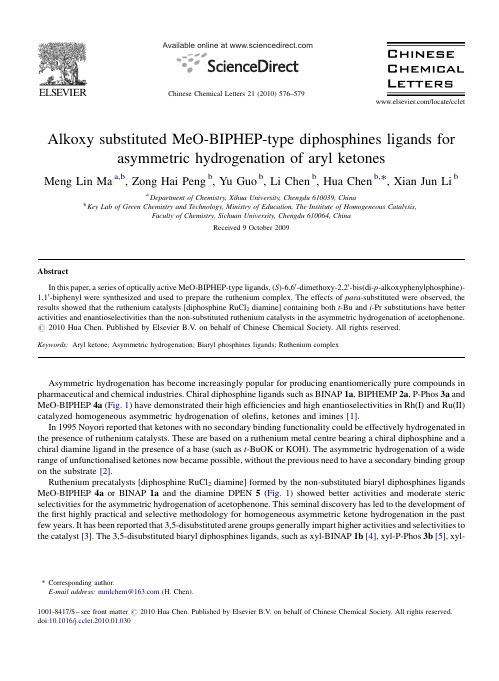
Alkoxy substituted MeO-BIPHEP-type diphosphines ligands forasymmetric hydrogenation of aryl ketonesMeng Lin Ma a ,b ,Zong Hai Peng b ,Yu Guo b ,Li Chen b ,Hua Chen b ,*,Xian Jun Li baDepartment of Chemistry,Xihua University,Chengdu 610039,ChinabKey Lab of Green Chemistry and Technology,Ministry of Education,The Institute of Homogeneous Catalysis,Faculty of Chemistry,Sichuan University,Chengdu 610064,ChinaReceived 9October 2009AbstractIn this paper,a series of optically active MeO-BIPHEP-type ligands,(S )-6,60-dimethoxy-2,20-bis(di-p -alkoxyphenylphosphine)-1,10-biphenyl were synthesized and used to prepare the ruthenium complex.The effects of para -substituted were observed,the results showed that the ruthenium catalysts [diphosphine RuCl 2diamine]containing both t -Bu and i -Pr substitutions have better activities and enantioselectivities than the non-substituted ruthenium catalysts in the asymmetric hydrogenation of acetophenone.#2010Hua Chen.Published by Elsevier B.V .on behalf of Chinese Chemical Society.All rights reserved.Keywords:Aryl ketone;Asymmetric hydrogenation;Biaryl phosphines ligands;Ruthenium complexAsymmetric hydrogenation has become increasingly popular for producing enantiomerically pure compounds in pharmaceutical and chemical industries.Chiral diphosphine ligands such as BINAP 1a ,BIPHEMP 2a ,P-Phos 3a and MeO-BIPHEP 4a (Fig.1)have demonstrated their high efficiencies and high enantioselectivities in Rh(I)and Ru(II)catalyzed homogeneous asymmetric hydrogenation of olefins,ketones and imines [1].In 1995Noyori reported that ketones with no secondary binding functionality could be effectively hydrogenated in the presence of ruthenium catalysts.These are based on a ruthenium metal centre bearing a chiral diphosphine and a chiral diamine ligand in the presence of a base (such as t -BuOK or KOH).The asymmetric hydrogenation of a wide range of unfunctionalised ketones now became possible,without the previous need to have a secondary binding group on the substrate [2].Ruthenium precatalysts [diphosphine RuCl 2diamine]formed by the non-substituted biaryl diphosphines ligands MeO-BIPHEP 4a or BINAP 1a and the diamine DPEN 5(Fig.1)showed better activities and moderate steric selectivities for the asymmetric hydrogenation of acetophenone.This seminal discovery has led to the development of the first highly practical and selective methodology for homogeneous asymmetric ketone hydrogenation in the past few years.It has been reported that 3,5-disubstituted arene groups generally impart higher activities and selectivities to the catalyst [3].The 3,5-disubstituted biaryl diphosphines ligands,such as xyl-BINAP 1b [4],xyl-P-Phos 3b [5],xyl-/locate/ccletAvailable online at Chinese Chemical Letters 21(2010)576–579*Corresponding author.E-mail address:mmlchem@ (H.Chen).1001-8417/$–see front matter #2010Hua Chen.Published by Elsevier B.V .on behalf of Chinese Chemical Society.All rights reserved.doi:10.1016/let.2010.01.030MeO-BIPHEP 4b [6]and xyl-TetraPHEMP 2b [7](Fig.1),were used in asymmetric hydrogenation of ketones and get good results,in which the steric influence of the 3,5-disubstituted was investigated.Due to the importance of the nature of substituents on the phosphorus atoms,we investigated the influence of newly designed MeO-BIPHEP-type atropisomeric diphosphines with para -alkoxy phenyl group at each of the phosphorus atom (Fig.2).The different structures of the alkoxy are expected to provide an opportunity to investigate the influence of the para -substituent in the asymmetric hydrogenation of ketones.In this paper,a series of chiral diphosphines 6,60-dimethoxy-2,20-bis(di-p -alkoxyphenylphosphine)-1,10-biphenyl were synthesized by an improvement way (Scheme 1)based on the Schmid method [8]and our improve way [9].In order to evaluate alkoxy substituted ligands,their corresponding ruthenium complexes were prepared according to literature methods [10](Scheme 2)and tested on the hydrogenation of acetophenone.Parallel experiments were performed to make direct comparison between our catalysts and reported ones.Basic reaction conditions were first optimized using acetophenone as substrate and p -methoxy-MeO-BIPHEP 4c phosphine ligand complex as a catalyst.M.L.Ma et al./Chinese Chemical Letters 21(2010)576–579577Fig.1.Ligands used for ketone hydrogenationcatalysts.Fig.2.Our biaryl diphosphineligands.Scheme 1.Reagents and conditions:(a)P(OEt)3,anhydrous NiCl 2,1408C,1h,87%yield or microwave,5min,94%yield,(b)(1)LDA in THF,À788C,(2)anhydrous FeCl 3in THF,À788C to rt.,16h,49%yield or (1)LTMP (BuLi +2,2,6,6-tetramethylpiperidine)in THF,À788C,(2)anhydrous FeCl 3in THF,À788C to rt.,16h,58%yield,(c)(1)(À)-DBTA in CH 2Cl 2/Et 2O,(2)10%NaOH/CH 2Cl 2,>99%ee,(d)SOCl 2,DMF,99%yield,(e)ArMgBr in THF,À788C to rt.,3h,95–68%yield or ArLi in THF,À788C to rt.,0.5h,46–35%yield,(f)HSiCl 3,Et 3N in toluene,reflux,98%yield,>99%ee.The catalytic activities of these ruthenium complexes in the hydrogenation of acetophenone were tested in i -Pr-OH,with a substrate/catalyst/base ratio (S/C/B)of 3000/1/100,at 508C and under 40bar of hydrogen (Table 1).The same ruthenium complexes were prepared with the MeO-BIPHEP in order to compare the activity and selectivity of ligands.As we have already observed with ligands 4c ,4d and 4e ,these alkoxy substituted almost have no influence either on the activity or on the selectivity (Table 1,entry 2,3and 4).Moreover some other para -substituent of the diphosphine ligands has the influence in the asymmetric hydrogenation of ketones.In our reaction conditions,the non-substituted MeO-BIPHEP ligands 4a provided 99%conversion to products and gave 81%ee at 208C (Table 1,entry 1).Different results were obtained because of their different chemical structures.The ligands substituted by para-t -Bu 4h and para-i -Pr 4f both gave good ee than non-substituted one,particularly the t -Bu-MeO-BIPHEP 4h could get 99%conversion with 97%ee (Table 1,entry 7).These results clearly indicated the strong influence of para -substituent with steric hindrance on the enantioselectivity of the reaction.With the optimal reaction conditions in hand,ligand 4h was used in the hydrogenation of a series of acetophenones derivatives (Table 2,entries 1–10).Excellent enantioselectivities ee were observed.The best result was hydrogenation of o -bromoacetophenone (Table 2,entry 7),in which the conversion to products was >99%with 99%ee.The o -chloroacetophenone (Table 2,entry 8)and o -trifluoromethylacetophenone (Table 2,entry 6)could get better ee at 97%.These results are comparable to the best results reported to date.In summary,we have investigated the influence of the para -substituent in the asymmetric hydrogenation of ketones,the results showed that new ruthenium catalysts [diphosphine RuCl 2diamine]containing the p -t -Bu-or p -i -Pr-substituted MeO-BIPHEP ligand were better than non-substituted ones in both activities and enantioselectivities.Further study will be focused on the synthesis and applications of other ortho -substituted MeO-BIPHEP ligands.M.L.Ma et al./Chinese Chemical Letters 21(2010)576–579578Scheme 2.Reagents and conditions:(a)DMF and [Ru(benzene)Cl 2]21008C,25min and (b)(S,S )-DPEN,258C,5h.The solvent DMF was removed by evaporated at 308C under reduced pressure.Table 1The effect of the para -alkoxy chain in the hydrogenation ofacetophenone..Entry Phosphine R 1R 2Con.(%)ee (%)a 14a CH 3H 9981b 24c CH 3H 998234d CH 3H >998444e CH 3H >998454f CH 3H >999264g CH 3H >998774h CH 3H >999784iCH 3H2977aReactions were run under 3Mp H 2and 208C in 50mL magnetically stirred Parr pressure vessels and in 12h.S/C/B 3000/1/100.Conversion and ees were determined by GC analysis (Chirasil DEX-CB column).bHenschke et al.reported 84%ee using RuCl 2[(S )-MeO-BIPHEP][(S,S )-DPEN]precatalyst and t -BuOK as base [7].M.L.Ma et al./Chinese Chemical Letters21(2010)576–579579 Table2The results of hydrogenation different acetophenones derivatives.Entry Phosphine R1R2Con.(%)ee(%) 1t-Bu-MeO-BIPHEP(4h)CH2CH3H>99822CH2(CH3)2H19783CH3p-CH3O89744CH3p-CF3>99845CH3o-CH3O53476CH3o-CF3>99987CH3o-Br>99998CH3o-Cl>99979CH3o-F986410CH3o-OH00 Reactions were run under3Mp H2,208C in50mL magnetically stirred Parr pressure vessels and in12h.S/C/B3000/1/100.Conversion and ees were determined by GC analysis(Chirasil DEX-CB column).AcknowledgmentsWe thank the NSFC(No.20272037),the Doctor’s Foundation of Education Ministry of China(No.20030610022) and Foundation of Xihua University(No.R0723315)and(No.07ZA109)for thefinancial support of this work. References[1](a)W.J.Tang,X.M.Zhang,Chem.Rev.103(2003)3029;(b)M.MacCarthy,P.J.Guiry,Tetrahedron57(2001)3809;(c)X.M.Zhang,Enantiomer4(1999)541.[2](a)R.Noyori,Angew.Chem.,Int.Ed.41(2002)2008;(b)R.Noyori,T.Ohkuma,Angew.Chem.,Int.Ed40(2001)40;(c)Z.G.Antonio,H.William,G.Michelle,et al.Platinum Met.Rev.49(2005)158.[3]P.Dotta,A.Magistrato,U.Rothlisberger,et anometallics21(2002)3033.[4]T.Ohkuma,M.Koizumi,K.Muniz,et al.J.Am.Soc.Chem.124(2002)6508.[5](a)J.Wu,H.Chen,W.Kwok,et .Chem.67(2002)7908;(b)J.Wu,J.X.Ji,R.Guo,et al.Eur.J.Chem.9(2003)2963.[6]B.H.Lipshutz,K.Noson,W.Chrisman,et al.J.Am.Soc.Chem.125(2003)8779.[7](a)J.P.Henschke,Z.G.Antonio,P.Moran,et al.Tetrahedron Lett.44(2003)4379;(b)J.P.Henschke,M.J.Burk,C.G.Malan,Adv.Synth.Catal.345(2003)300.[8](a)R.Schmid,E.A.Broger,M.Cereghetti,Pure Appl.Chem.68(1996)131;(b)E.A.Broger,J.Foricher,R.Schmid,US5,274,125,1993,Chem.Abstr.1993,118,P59878a;;(c)J.Foricher,B.Heiser,R.Schmid,US5,302,738,1994,Chem.Abstr.1993,118,P147774u;;(d)londe,5,536,858,1996,Chem.Abstr.1996,124,P8995c.[9]M.L.Ma,Z.H.Peng,H.Chen,J.Chin.Chem.24(2006)1391.[10]H.Doucet,T.Okhuma,R.Noyori,Angew.Chem.,Int.Ed.37(1998)1703.。
辐射新维加斯杂物代码
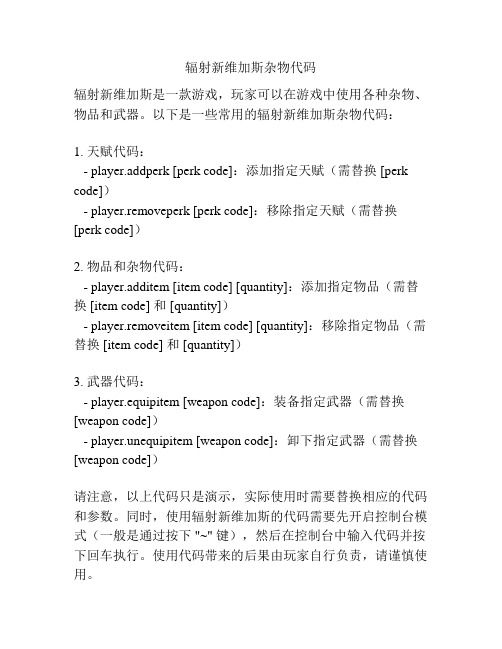
辐射新维加斯杂物代码
辐射新维加斯是一款游戏,玩家可以在游戏中使用各种杂物、物品和武器。
以下是一些常用的辐射新维加斯杂物代码:
1. 天赋代码:
- player.addperk [perk code]:添加指定天赋(需替换 [perk code])
- player.removeperk [perk code]:移除指定天赋(需替换[perk code])
2. 物品和杂物代码:
- player.additem [item code] [quantity]:添加指定物品(需替换 [item code] 和 [quantity])
- player.removeitem [item code] [quantity]:移除指定物品(需替换 [item code] 和 [quantity])
3. 武器代码:
- player.equipitem [weapon code]:装备指定武器(需替换[weapon code])
- player.unequipitem [weapon code]:卸下指定武器(需替换[weapon code])
请注意,以上代码只是演示,实际使用时需要替换相应的代码和参数。
同时,使用辐射新维加斯的代码需要先开启控制台模式(一般是通过按下 "~" 键),然后在控制台中输入代码并按下回车执行。
使用代码带来的后果由玩家自行负责,请谨慎使用。
中英文催化剂的制备与表征(catalysis and physical properties)

Introduction to this subject
➢ Preparation, characterization and application of a catalyst is crucial to innovate a novel catalyst.是发明一个新催化剂的关键。
➢ Catalyst is usually not the same with other chemicals, especially pure chemicals.催化剂一般与其他化学品一样,特别是纯化学品。
Definition of Catalyst
➢ Ostwald (德国)的观点 催化剂是一种能够改变化学反应的速度,而它本身又不 参与最终产物的 物质。 (流行)
➢ IUPAC定义: 催化剂能够加速反应速率而不改变反应的标准Gibbs自 有焓变化。
➢ 国内新近定义 催化时加速反应速度、控制反应方向或产物构成,而不 影响化学平衡的一类作用。起这种作用的物质称为催化 剂,它不在主反应的化 学计量式中反映出来,即在反应 中不被消耗。
Ideal surface is not perfect
理想的表面是不完美的
扭结
阶梯空位
阶梯位
台阶吸附的原子 台阶空位
球的堆积模型表示不完美表面
Heterogeneous Catalyst
* Metals (Transition metals, IB metals);金属
Fe Co Ni Ru Rh Cu Ag Au Pd Os Ir Pt
Mechanism for heterogeneous Catalysis
Heterogeneous Catalysis
➢ Heterogeneous mechanism is difficult to investigated in the laboratory. Disappearance of reactants and appearance of products are easily followed, but important features such as the rates and energetic of adsorption, structure of active sites, the nature of active intermediates, require separate experimentation using a constantly changing arsenal of techniques. 非均相机理的实验室研究非常困难。反应物的消耗和产物的生成比 较容易追踪,但许多重要的因素比如速度和吸附能,活性位结构、 活性中间体特点等需要通过大量的单因素实验来得出。
SMC产品说明书:PPA100 PPA101 PPA102型号的Compact Manometer

Instruction Manual Compact ManometerPPA100 / PPA101 / PPA102The intended use of this product is for pressure measurement.These safety instructions are intended to prevent hazardous situations and/or equipment damage. These instructions indicate the level of potential hazard with the labels of “Caution,” “Warning” or “Danger.”They are all important notes for safety and must be followed in addition to International Standards (ISO/IEC) *1), and other safety regulations. *1)ISO 4414: Pneumatic fluid power - General rules relating to systems. ISO 4413: Hydraulic fluid power - General rules relating to systems.IEC 60204-1: Safety of machinery - Electrical equipment of machines. (Part 1: General requirements)ISO 10218-1: Robots and robotic devices - Safety requirements for industrial robots - Part 1: Robots.• Refer to product catalogue, Operation Manual and Handling Precautions for SMC Products for additional information. • Keep this manual in a safe place for future reference.CautionCaution indicates a hazard with a low level of risk which, if not avoided, could result in minor or moderate injury.WarningWarning indicates a hazard with a medium level of riskwhich, if not avoided, could result in death or serious injury.DangerDanger indicates a hazard with a high level of risk which, ifnot avoided, will result in death or serious injury.Warning• Always ensure compliance with relevant safety laws and standards.• All work must be carried out in a safe manner by a qualified person in compliance with applicable national regulations.• Refer to the operation manual or catalogue on the SMC website (URL: https://) for further Safety Instructions.2 Specifications2.1General specificationsModelPPA100 High pressure PPA101 Vacuum PPA102 Low pressure Rated pressure range-0.1 to 1 MPa -101 to 10 kPa -10 to 100kPaDisplay method 3 digit LCD with backlight Pressure displaydiscrimination1/100Minimum display unit kPa - 1 1 MPa 0.01 - -mmHg- 5 - kgf/cm 20.1 0.01 0.01 inHg - 0.2 -psi 1 0.1 0.1 bar 0.1 0.01 0.01Error displayOver pressure, Memory data error,Change battery signFunctionPeak / bottom display, backlight, Auto powerOFF, Zero clear, Units display switchingWithstand pressure 1.5 MPa 200 kPa 200 kPa Applicable fluid Air, Non-corrosive gases, non-flammable gas Power supply voltage 3 VDC, Type AA dry cell x 2 pcs.Battery life12 months continuous operation(without backlight, at 25°C)Response speed 250 ms Display accuracy ±2% F.S. (at 25°C) Repeatability ±1% F.S. (at 25°C) Temperaturecharacteristics±3% F.S. (0 to 50°C with 25°C standard)Connection port size M5 x 0.8 Operatingtemperature range 0 to 50°C (no condensation)Operating humidityrange35 to 85% RH (no condensation)Enclosure rating IP40 Weight 100 g (Unit: 50 g, Battery: 50 g) *1) Batteries (manganese R6 or alkaline LR6) not included.*2) For the type without the unit switching function are fixed to SI units (kPa or MPa.*3) With regard to the compatibility condition for EMC, the pressure display value variation is ±15% F.S. or less.WarningSpecial products (-X) might have specifications different from those shown in this section. Contact SMC for specific drawings.3 Installation3.1 InstallationWarning• Do not install the product unless the safety instructions have been read and understood.3.2 EnvironmentWarning• Do not use in an environment where corrosive gases, chemicals, salt water or steam are present.• Do not use in an explosive atmosphere.• Do not expose to direct sunlight. Use a suitable protective cover.• Do not install in a location subject to vibration or impact in excess of the product’s specifications.• Do not operate in a location exposed to radiant heat that would result in temperatures in excess of the product’s specifications.3.3 PipingCaution• Before connecting piping be sure to clean up chips, cutting oil, dust etc. • When installing piping or fittings, ensure sealant material does not enter inside the port. When using seal tape, leave 1 thread exposed on the end of the pipe/fitting.• Tighten fittings to the specified tightening torque.3.4 LubricationCaution• SMC products have been lubricated for life at manufacture, and do not require lubrication in service.• If a lubricant is to be used in the system, refer to catalogue for details.4 Settings4.1 Initial SettingPerform initial setting when using for the first time and after changing the batteries, as the unit will display a memory data error.1. Confirmation of displayWhen power is applied, if there is nothing on the display, proceed to step 2.If “Err” Is displayed on the LCD, switch the power OFF and ON again. The display should clear. Proceed to step 2.2. Press and hold the POWER button for 6 seconds or more.The unit will move into the zero-clear mode. When this happens “CAL” will be displayed.3. Release the POWER button.When zero clear is finished, the unit will operate.4.2 Power ONPress the POWER button. The power will turn ON.When pressed and held for 6 seconds or more the unit will move into zero-clear mode.4.3 Power OFFPress and hold the POWER button for 3 seconds or more.The power will turn OFF.The power will also turn OFF If there is no button operation for 5 minutes or more (auto power OFF function).4.4 Units Display Switching1. Press and hold the POWER and LIGHTbuttons for 3 seconds or more.The units on the LCD display will flash.2. Press the LIGHT buttonThe units will change (refer to the units table).3. Press the POWER buttonThe units are set and the units display setting is complete.(For products with units switching function).Units availableHigh pressure (PPA100) Vacuum pressure(PPA101) Low pressure (PPA102) MPa > bar > psi > kgfkPa > bar > psi > inHg > mmHgkPa > bar > psi > kgf4.5 Peak / Bottom displayPress the POWER button. • For Peak displayTo display the maximum pressure value, with “P” displayed on the LCD. The display will change if the pressure exceeds the pressure being held.Press the POWER button. • For Bottom displayTo display the minimum pressure value, with “b” displayed on the LCD. The display will change if the pressure falls below the pressure being held. Press the POWER to complete the setting.Since this function is combined with the power OFF operation, the button should be released when the “P” or “b” is displayed.4.6 Auto Power OFF functionThe power is turned OFF when there has been no button operation for 5 minutes.(To cancel this function refer to the lock mode function below).4.7 Lock mode functionPress and hold the POWER and LIGHT buttons for 6 seconds or more.The lock mode is activated and the auto power OFF function is cancelled.“L” is displayed on the LCD display.When the power is turned OFF the lock mode is released.4.8 Turning ON the BacklightPress the LIGHT button.The display lights up when the button is pressed. In lock mode it lights up when pressed and turns OFF when pressed again.However the maximum lighting time is approximately one minute.4.9 Zero clear functionPress the POWER button for 6 seconds or more.The zero displayed at atmospheric pressure can be automatically adjusted.This means it is possible to eliminate a display discrepancy at atmospheric pressure. 1. Turn the power OFF.2. Release the supply pressure to atmosphere.3. When the POWER button is pressed and held for 6 seconds or more the zero clear function is performed and “CAL” is displayed on the LCD.ORIGINAL INSTRUCTIONSRefer to the operation manual or catalogue on the SMC website (URL: https:// ) for the How to Order information.Refer to the operation manual or catalogue on the SMC website (URL: https:// ) for outline dimensions.7.1 General maintenanceCaution•Not following proper maintenance procedures could cause the productto malfunction and lead to equipment damage.• If handled improperly, compressed air can be dangerous.Maintenance of pneumatic systems should be performed only by qualified personnel.• Before performing maintenance, turn off the power supply and be sure to cut off the supply pressure. Confirm that the air is released to atmosphere.• After installation and maintenance, apply operating pressure and power to the equipment and perform appropriate functional and leakage tests to make sure the equipment is installed correctly.• If any electrical connections are disturbed during maintenance, ensure they are reconnected correctly and safety checks are carried out as required to ensure continued compliance with applicable national regulations.• Do not make any modification to the product.• Do not disassemble the product, unless required by installation or maintenance instructions. 7.2 Span calibrationWarning• Do not touch the span calibration trimmer except when performing a span calibration.1. Perform zero clear at atmospheric pressure.2. Apply the maximum rated pressure and calibrate the span while comparing with a standard pressure gauge.3. If the displayed value of the compact manometer is “0” after returning to atmospheric pressure, then calibration is complete. If the displayed value is not “0” calibrate again by repeating steps 1 and 2.7.3 Replacing the batteriesWhen the battery voltage becomes low the entire LCD display will flash. When the LCD is flashing, replace the batteries. Use 2 x AA dry cell batteries.Caution• To replace the batteries, turn OFF the power and replace them within approximately 30 seconds.• If not completed within 30 seconds “Err” will be displayed. • In that case perform zero clear once again.• In the event that the display runs out of control, remove the batteries for one minute or longer and then perform zero clear again before inserting the batteries and turning ON the power.8.1 Limited warranty and disclaimer/compliance requirements Refer to Handling Precautions for SMC Products.This product shall not be disposed of as municipal waste. Check your local regulations and guidelines to dispose of this product correctly, in order to reduce the impact on human health and the environment.10 ContactsRefer to or www.smc.eu for your local distributor / importer.URL: https:// (Global) https://www.smc.eu (Europe) SMC Corporation, 4-14-1, Sotokanda, Chiyoda-ku, Tokyo 101-0021, Japan Specifications are subject to change without prior notice from the manufacturer. © 2021 SMC Corporation All Rights Reserved. Template DKP50047-F-085M。
Chemical Reaction Engineering
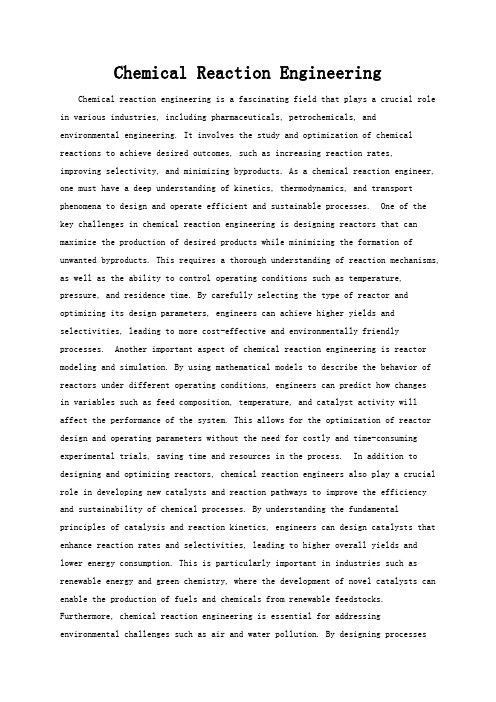
Chemical Reaction Engineering Chemical reaction engineering is a fascinating field that plays a crucial role in various industries, including pharmaceuticals, petrochemicals, and environmental engineering. It involves the study and optimization of chemical reactions to achieve desired outcomes, such as increasing reaction rates,improving selectivity, and minimizing byproducts. As a chemical reaction engineer, one must have a deep understanding of kinetics, thermodynamics, and transport phenomena to design and operate efficient and sustainable processes. One of the key challenges in chemical reaction engineering is designing reactors that can maximize the production of desired products while minimizing the formation of unwanted byproducts. This requires a thorough understanding of reaction mechanisms, as well as the ability to control operating conditions such as temperature, pressure, and residence time. By carefully selecting the type of reactor and optimizing its design parameters, engineers can achieve higher yields and selectivities, leading to more cost-effective and environmentally friendly processes. Another important aspect of chemical reaction engineering is reactor modeling and simulation. By using mathematical models to describe the behavior of reactors under different operating conditions, engineers can predict how changesin variables such as feed composition, temperature, and catalyst activity will affect the performance of the system. This allows for the optimization of reactor design and operating parameters without the need for costly and time-consuming experimental trials, saving time and resources in the process. In addition to designing and optimizing reactors, chemical reaction engineers also play a crucial role in developing new catalysts and reaction pathways to improve the efficiency and sustainability of chemical processes. By understanding the fundamental principles of catalysis and reaction kinetics, engineers can design catalysts that enhance reaction rates and selectivities, leading to higher overall yields and lower energy consumption. This is particularly important in industries such as renewable energy and green chemistry, where the development of novel catalysts can enable the production of fuels and chemicals from renewable feedstocks. Furthermore, chemical reaction engineering is essential for addressing environmental challenges such as air and water pollution. By designing processesthat minimize the generation of harmful byproducts and pollutants, engineers can help reduce the environmental impact of chemical manufacturing and ensure compliance with regulatory standards. This requires a holistic approach that considers not only the technical aspects of reactor design and operation but also the broader implications for human health and the environment. Overall, chemical reaction engineering is a dynamic and multidisciplinary field that plays a vital role in advancing technology and addressing global challenges. By combining knowledge from chemistry, physics, and engineering, chemical reaction engineers can develop innovative solutions to complex problems and contribute to the sustainable development of society. Whether it's designing a new reactor system, optimizing an existing process, or developing a novel catalyst, chemical reaction engineers are at the forefront of innovation and progress in the chemical industry.。
介绍游戏英文

Gameplay
Deathmatch Mode
Deathmatch mode is a more traditional mode of play where players compete to achieve the highest number of kills. The mode is played on smaller maps and there are no teams, so players can respawn immediately after being killed
and improvements
that enhance the gameplay experience. The game's fast-paced and strategic gameplay, along with its diverse maps and modes, make it a must-play for fans of first-person shooters
-
THANKS
感谢您的观看
Gameplay
Hostage Rescue Mode
Hostage rescue mode is a popular mode where one team must rescue hostages held by the other team. The hostage rescue team must release the hostages from their captors and escort them to a safe zone, while the captors must prevent this from happening. The mode adds an extra layer of strategy and cooperation to the game
MyLifeOrganized教程
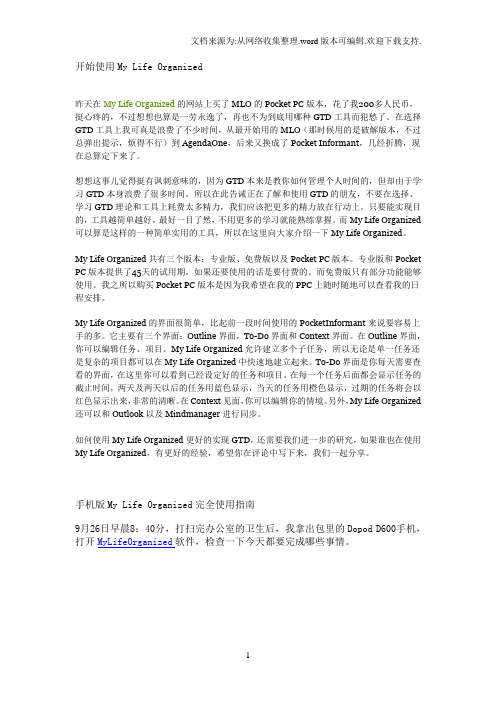
开始使用My Life Organized昨天在My Life Organized的网站上买了MLO的Pocket PC版本,花了我200多人民币,挺心疼的,不过想想也算是一劳永逸了,再也不为到底用哪种GTD工具而犯愁了。
在选择GTD工具上我可真是浪费了不少时间,从最开始用的MLO(那时候用的是破解版本,不过总弹出提示,烦得不行)到AgendaOne,后来又换成了Pocket Informant,几经折腾,现在总算定下来了。
想想这事儿觉得挺有讽刺意味的,因为GTD本来是教你如何管理个人时间的,但却由于学习GTD本身浪费了很多时间。
所以在此告诫正在了解和使用GTD的朋友,不要在选择、学习GTD理论和工具上耗费太多精力,我们应该把更多的精力放在行动上。
只要能实现目的,工具越简单越好,最好一目了然,不用更多的学习就能熟练掌握。
而My Life Organized 可以算是这样的一种简单实用的工具,所以在这里向大家介绍一下My Life Organized。
My Life Organized共有三个版本:专业版、免费版以及Pocket PC版本。
专业版和Pocket PC版本提供了45天的试用期,如果还要使用的话是要付费的。
而免费版只有部分功能能够使用。
我之所以购买Pocket PC版本是因为我希望在我的PPC上随时随地可以查看我的日程安排。
My Life Organized的界面很简单,比起前一段时间使用的PocketInformant来说要容易上手的多。
它主要有三个界面:Outline界面,To-Do界面和Context界面。
在Outline界面,你可以编辑任务、项目。
My Life Organized允许建立多个子任务,所以无论是单一任务还是复杂的项目都可以在My Life Organized中快速地建立起来。
To-Do界面是你每天需要查看的界面,在这里你可以看到已经设定好的任务和项目。
在每一个任务后面都会显示任务的截止时间,两天及两天以后的任务用蓝色显示,当天的任务用橙色显示,过期的任务将会以红色显示出来,非常的清晰。
L-脯氨酸衍生物催化的不对称Michael加成反应

L-脯氨酸衍生物催化的不对称Michael加成反应刘杰 (有机化学)摘要:有机小分子有着不含贵金属、温和、廉价、对环境友好等优点,其应用已成为催化领域的重要发展趋势。
有机小分子催化的不对称合成反应是目前研究最为活跃的领域之一。
Michael加成反应在有机合成中是一种非常重要的形成碳碳键的反应。
近来,许多手性小分子催化剂被用于催化不对称Michael加成反应。
脯氨酸作为一种结构简单而且含量丰富的手性小分子催化剂在多种不对称催化反应中表现出的非常好的催化性能。
本文的主要工作是从以下两个方面对脯氨酸衍生物催化的不对称Michael加成反应进行了研究:(1)设计并制备了四种Merrifield树脂负载的含脯氨酸单元的手性小分子催化剂,经过实验,发现其中一种在催化Michael加成反应时是非常有效的,当使用5 mol%的该催化剂来催化环己酮和取代硝基苯乙烯时,产率最高可以达到92 %,ee值最高可以达到98 %,d. r.值最高可以达到99:1。
另外该催化剂可以循环使用5次以上,产率上只有很小的减少,而ee值基本不发生改变。
(2)设计并制备了一种糖-四氢吡咯催化剂,通过“Click”反应将 D-glucose 骨架与四氢吡咯连接在一起,在催化 Michael 加成反应时取得了良好效果,仅需要10 mol%的催化剂,在无溶剂条件下室温下反应24小时,产率高达98 %,ee 值大于99 %,d. r.大于99:1。
以上结果与一些天然氨基酸催化的Michael加成反应相比,不仅提高了产率和立体选择性,而且扩大了底物的范围,增大了反应的广谱性。
另外,我们还对功能化离子液体系中发生的 Heck 反应进行了研究。
设计并制备了三种功能化离子液,其中一种在催化Heck反应时非常有效。
该离子液既可作为配体又可作为碱。
在优化条件下,产率较高,且循环六次产率基本没有发生改变。
关键词:有机小分子催化,不对称Michael加成反应,脯氨酸衍生物,Heck 反应,功能化离子液,Pd粉L-Proline’s derivatives Catalyzed AsymmetricMichael AdditionJie Liu(Organic Chemistry)Abstract:Organic catalysts without noble metals have played an important role in the development of the catalytic reaction, due to their moderate effect, cost efficiency, environment friendly and other advantages. Organocatalytic asymmetric reaction is an increasingly active area in oraganic sythesis.The Michael addition reaction is one of the most important carbon-carbon bond-forming reactions in organic synthesis. Asymmetric organocatalytic Michael addition has attracted intense interests in the recent few years due to its stability, cheapness and the generation of multiple chiral centers in a single step. Recently, quite a number of small chiral organic molecules have been developed as stereoselective catalysts for asymmetric Michael reactions. Proline has been gradually recognized as a simple, abundant and powerful chiral catalyst for many asymmetric reactions.In this context, Asymmetric Michael addition reaction is studied from two sides as following.(1) One of the four Merrifield resin-supported pyrrolidine-based chiral organocatalysts,through A3-coupling reaction linkage have been developed and found to be highly effective catalysts for the Michael addition reaction of ketones with nitrostyrenes. The reactions generated the corresponding products in good yields (up to 98 %), excellent enantioselectivies (up to 98 % ee) and high diastereoselectivities (up to 99:1 d.r.). In addition, the catalysts can be reused at least five times without a significant loss of catalytic activity and stereoselectivity.(2) A modular sugar-based pyrrolidine was prepared and was found to be a highly enantioselective and cooperative organocatalyst for asymmetric Michael addition of ketones to nitrostyrenes. In the presence of 10 mol% of the organocatalysts,a pyrrolidine unit anchored to a natural D-glucose backbone through click chemistry, the Michael additions of ketones to nitrostyrenes underwent smoothly to generate the corresponding adducts in good yields (up to 98 %), high enantioselectivities (up to >99 % ee) and excellent diastereoselectivities (up to >99:1 d.r.) under solvent-free reaction conditions.In contrast to the above catalysts, some natural amino acids catalyzed the Michael addition reactions in low yields and stereoselectivities, or the substrates are very limited.In addition, we made research on the study of Heck reaction in ionic liquids. A kind of amino-functionalized ionic liquids has been prepared and investigated as ligand and base for the Heck reactions between aryl iodides and bromides with olefins in the presence of a catalytic amount of Pd submicron powder in [Bmim]PF6. The reactions generated the corresponding products in excellent yields under mild reaction conditions. The generality of this catalytic system to the different substrates also gave the satisfactory results. The key feature of the reaction is that Pd species and ionic liquids were easily recovered and reused for six times with constant activity.Keywords: Organocatalysis, Asymmetric Michael addition reaction, proline’s derivates Heck reaction; functionalized ionic liquids; Pd submicron powder.目 录第一章研究背景 (2)1.1 不对称合成的意义 (2)1.2 不对称合成的方法 (3)1.3 手性催化法 (4)1.4 脯氨酸简介 (5)参考文献 (20)第二章 Merrifield树脂负载的脯氨酸衍生物催化的不对称Michael加成反应 (28)2.1 引言 (28)2.2 结果与讨论 (28)2.3 实验部分 (34)2.4 化合物的结构表征 (37)参考文献 (41)第三章糖-四氢吡咯催化不对称Michael加成反应的研究 (43)3.1 引言 (43)3.2 结果与讨论 (43)3.3 实验部分 (48)3.4 化合物的结构表征 (49)参考文献 (55)第四章功能化离子液体系中钯催化的Heck反应 (57)4.1 引言 (57)4.2 结果与讨论 (58)4.3 实验部分 (63)4.4 化合物的结构表征 (64)参考文献 (67)附I 部分化合物谱图 (70)附录II 硕士期间发表论文题录 (77)致 谢 (78)第一章 研究背景1.1 不对称合成的意义手性(chirality)一词源于希腊语,在多种学科中表示一种重要的对称特点。
CATalyst 3.0 安装手册

版权声明版权声明本软件产品(包括所含的任何程序、图像、文档和随附的印刷材料),以及本软件产品的任何副本的产权和著作权,均属广州广电运通金融电子股份有限公司所有。
您不得使用任何工具或任何方式对本软件产品进行反向工程,反向编译。
未经广州广电运通金融电子股份有限公司许可,您不得以任何目的和方式发布本软件产品及任何相关资料的部分或全部,否则您将受到严厉的民事和刑事制裁,并在法律允许的范围内受到最大可能的民事起诉。
目录目录1. 产品说明 (1)1.1.产品更新说明 (1)1.2.产品部件列表 (1)2. 安装前准备 (2)3. 安装 (3)3.1.安装说明 (3)3.2.系统配置 (10)3.3.启动和关闭 (18)3.4.系统安装测试 (19)4. 卸载 (20)5. 产品升级 (21)5.1.实现步骤 (21)5.2.条件限制 (21)6. 服务支持 (23)前言前言非常感谢您选用广州广电运通金融电子股份有限公司的CAT alyst 3.0 ,为了便于您的操作,请仔细阅读本产品的相关手册。
CAT alyst 3.0 说明书包括以下三本手册:●《CAT alyst 3.0 用户使用手册》描述了CAT alyst 3.0 所提供的功能、特性说明和更新说明;详细描述了系统的使用方法,如:使用前准备,系统结构,系统包括的各种开发、调试工具以及各种工具的具体功能使用方法等。
预期读者:系统管理员、用户●《CAT alyst 3.0 安装手册》描述了CAT alyst 3.0 所提供的功能、特性说明、产品部件明细和更新说明;详细描述系统安装、卸载及升级的操作流程,如:安装前准备、软件安装、系统配置、软件卸载、软件的启动和关闭等。
预期读者:工程人员、系统管理员●《CAT alyst 3.0 维护手册》描述了CAT alyst 3.0 所提供的功能、特性说明和更新说明;列举了系统常见问题及解决方法和出错处理。
预期读者:维护人员、系统管理员文档约定文档约定本手册使用以下约定,以区分手册中其它部分。
D2 dictionary

ik|野蛮人套装不朽之王的简称
tal|塔拉夏套装
naj|女巫套装娜吉
nat|刺客套装的简称
sigon|西刚套装
laying|门徒套装的手套
Mavina|亚玛逊玛维娜套装的简称,或写 mvn
ama|亚玛逊,其它同意思的还有 zon,amz
icob|提升抵挡概率
leech|吸血/吸魔法力/吸取经验值
pe|完美绿宝石
pd|完美白钻石 / 毒伤害
pa|完美紫水晶
ps|完美骷髅 /完美蓝宝石
pt|完美黄宝石 / 普通难度 / 或在论坛指骗贴。
pg|完美宝石
bs|宝石
cg|碎裂宝石,最低级的宝石
slpg|碎裂宝石,最低级的宝石
js|J商
KX|例如 kc/kp/km/kb,战网的主要活动,KC=杀牛;KP=杀第五场景底下红门进去后的第一个金怪;KM=杀孟菲斯托;KB=杀巴尔
CK|牛王,重点保护对象
lag|网络延迟,一般就是网速慢的意思
lol|大笑,其他类似的很多 ^o^,-o-,-_- 等等
lv|级别,等级
mf|获得魔法物品机会,一般是指一种行为
cbf|不被冰冻属性
fhr|快速恢复打击
fcr|快速施展法术
mdr|减轻魔法伤害
itd|忽略目标防御力
ias|提升快攻击速度
eth|不能修复的一次性物品
frw|快速移动/奔跑属性
req|物品的装备要求,一般包括强壮,敏捷,级别等
ce|男巫的尸爆技能
gm|男巫的傀儡掌握技能
pn|男巫的毒之新星技能
负载型铂催化剂催化苯乙烯硅氢加成反应
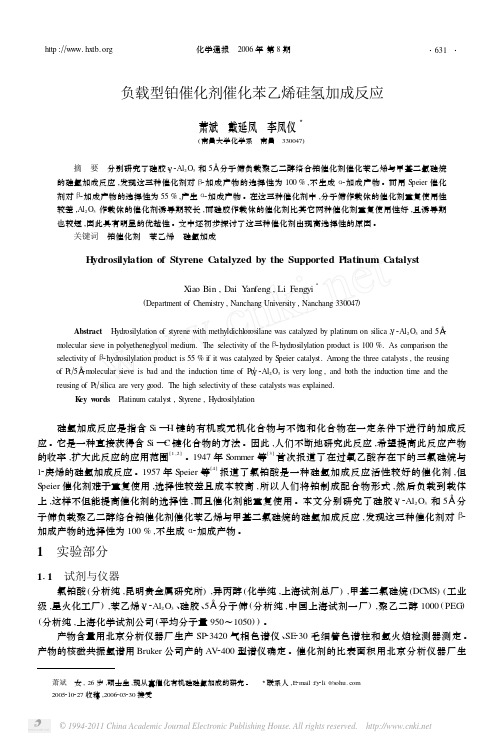
1 实验部分
111 试剂与仪器
氯铂酸 ( 分析纯 ,昆明贵金属研究所) ,异丙醇 ( 化学纯 ,上海试剂总厂) ,甲基二氯硅烷 ( DCMS) ( 工业 γ 级 ,星火化工厂) ,苯乙烯 、 2Al2 O3 、 硅胶 、 5 ! 分子筛 ( 分析纯 , 中国上海试剂一厂 ) , 聚乙二醇 1000 ( PEG)
tΠ h
η Π%
9116 9010 9417 8814 9111 9318 9219
SαΠ%
Sβ Π%
(m2Π 比表面积Π g)
0125 3 11 215 2 3 2
45
55 100 100 100 25819 125 24217
2116 1815 2114
7914 8115 7816
实验结果表明 ,用以上几种催化剂进行苯乙烯与 DCMS 的硅氢加成反应时 , 苯乙烯的转化率相近 , 催化活性无明显差异 。但这几种催化剂完成反应的时间存在差异 。 Speier 催化剂因为是均相催化剂所 以反应速率快 , 加入络合剂 PEG 的多相催化剂的反应时间较长 ;1 号和 3 号催化剂载体的比表面积相 近 ,反应速率相近 ; 但 2 号催化剂载体的表面积较 1 号和 3 号小 ,则反应速率较慢 ,这结果表明 ,载体的 比表面积大 ,苯乙烯和 DCMS 与活性组分接触的机率大 , 使反应速率增快 。 1、 2、 3 号催化剂出现高选择 性的原因可能是因为铂与 PEG 络合 ,在进行硅氢加成反应时催化剂的空间位阻大 , DCMS 只能加成到 苯乙烯位阻较小的 β 2位上 。
硅氢加成反应是指含 Si —H 键的有机或无机化合物与不饱和化合物在一定条件下进行的加成反 应 。它是一种直接获得含 Si — C 键化合物的方法 。因此 ,人们不断地研究此反应 ,希望提高此反应产物 [1 ,2 ] [3 ] 的收率 ,扩大此反应的应用范围 。1947 年 Sommer 等 首次报道了在过氧乙酸存在下的三氯硅烷与 [4 ] 12庚烯的硅氢加成反应 。1957 年 Speier 等 报道了氯铂酸是一种硅氢加成反应活性较好的催化剂 , 但
系列讲座之十七(Albert S. C. Chan)
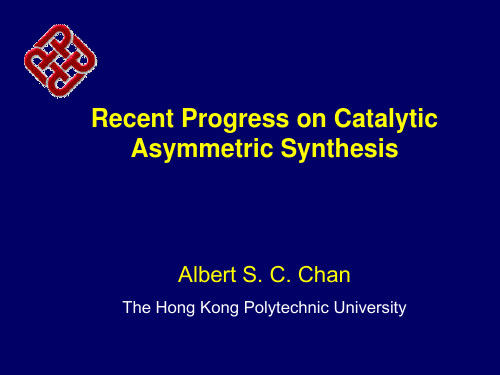
O R1
O OR2
Ru(S-P-Phos)Cl2(DMF)n 50 psi H2
OH O R1 * OR2
P 2
up to 99% ee
R1 = Ph, R2 = Et: 95% ee (BINAP: 85% ee)
(R)-P-Phos
Ru(S-P-Phos)(acac)2, 1000 psi H2 CO2H MeO H3PO4/Sub = 0.6 (M/M) Sub/Cat = 200 (M/M) MeO Me CO2H
(S)-Monophos
(1S,1'S,2R,2'R)-Tangphos
H3CH2C
R P P R R P R O O O P O H3CH2C P CH2CH3 Fe
P CH2CH3
R = Me, (R,R)-Me-Duphos R = Et, (R,R)-Et-Duphos R = i-Pr, (R,R)-iPr-Duphos
[Rh(NBD)2]BF4 (1R,1’R,2S,2’S)-Tangphos
100 1000 20 15 45 (R)
100 1000 24 4 ND
100 1000 48 7 62 (S)
Recent Progress on Catalytic Asymmetric Synthesis
Albert S. C. Chan
The Hong Kong Polytechnic University
Louis Pasteur Chemist 1822 - 1895
“Chance favors only the prepared mind.”
含吡啶基手性膦配体铜配合物催化下芳香酮的不对称硅氢化反应
思科 Stealthwatch 6.8(第 1.1 版) 猎捕邪恶!演示指南说明书

Cisco dCloudStealthwatch 6.8(第 1.1 版)—猎捕邪恶!最后更新日期:2017 年 2 月 13 日关于此演示“Stealthwatch 6.8(第 1.1 版)猎捕邪恶!”演示指南包括以下内容:要求拓扑入门指南帐户和密码场景 1:WebUI场景 2:Swing 客户端场景 3:检查主机组设置场景 4:执行流量查询场景 5:使用文档场景 6:确认规则/策略参数场景 7:调查警告场景 8:版权侵犯事件场景 9:检验思科 TrustSec 实施情况场景 10:恶意软件调查场景 11:调查代理连接场景 12:内部威胁检测场景 13:构建审计追踪附录 A:额外资源Cisco dCloud关于此解决方案思科 StealthWatch 通过收集并分析网络数据,为您的网络提供全面的可视性和保护,即使是规模最大、变动最频繁的网络,也尽在其掌握之中。
Stealthwatch 分析来自思科和其他供应商的路由器、交换机、防火墙和其他网络设备的行业标准 NetFlow 数据,以检测高级长期安全威胁,如内部传播的恶意软件、数据泄露、僵尸网络命令和控制流量和网络侦察。
作为对抗隐秘、复杂网络攻击的关键组成部分,Stealthwatch 通过分析网络内部(局域网和边界)的流量模式提供行为见解。
思科身份服务引擎 (ISE) 解决方案使用情景信息(如用户身份、用户权限级别、设备类型和状态)补充 Stealthwatch 基于 NetFlow 的威胁行为检测数据。
同时,StealthWatch 和思科 ISE 可为网络安全分析师提供一个集成用户、设备信息和网络流量数据的建议,使安全分析师能够以及时、高效且具成本效益的方式检测和辩明潜在威胁的严重程度。
此演示旨在让您熟悉思科 Stealthwatch 解决方案的用法。
您将在模拟的企业环境中与先前配置和部署的解决方案进行交互。
Stealthwatch 包括若干核心和可选组成部分。
辐射4神器代码
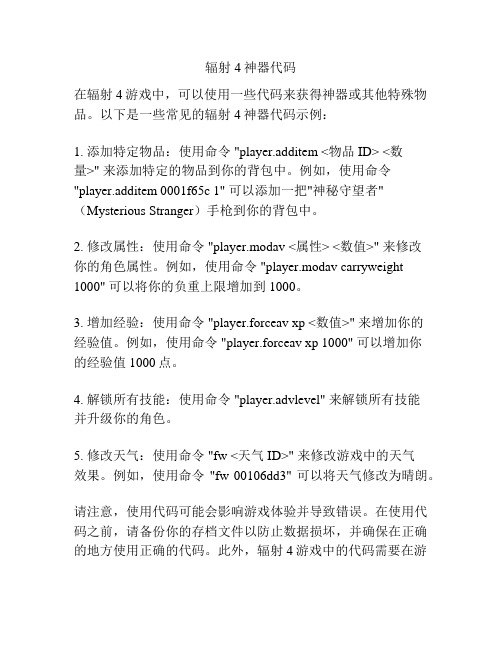
辐射4神器代码在辐射4游戏中,可以使用一些代码来获得神器或其他特殊物品。
以下是一些常见的辐射4神器代码示例:1. 添加特定物品:使用命令 "player.additem <物品ID> <数量>" 来添加特定的物品到你的背包中。
例如,使用命令"player.additem 0001f65c 1" 可以添加一把"神秘守望者"(Mysterious Stranger)手枪到你的背包中。
2. 修改属性:使用命令 "player.modav <属性> <数值>" 来修改你的角色属性。
例如,使用命令 "player.modav carryweight 1000" 可以将你的负重上限增加到1000。
3. 增加经验:使用命令 "player.forceav xp <数值>" 来增加你的经验值。
例如,使用命令 "player.forceav xp 1000" 可以增加你的经验值1000点。
4. 解锁所有技能:使用命令 "player.advlevel" 来解锁所有技能并升级你的角色。
5. 修改天气:使用命令 "fw <天气ID>" 来修改游戏中的天气效果。
例如,使用命令"fw 00106dd3" 可以将天气修改为晴朗。
请注意,使用代码可能会影响游戏体验并导致错误。
在使用代码之前,请备份你的存档文件以防止数据损坏,并确保在正确的地方使用正确的代码。
此外,辐射4游戏中的代码需要在游戏控制台中输入才能生效,因此请确保已经打开控制台并正确输入代码。
羰基化rh基均相催化剂
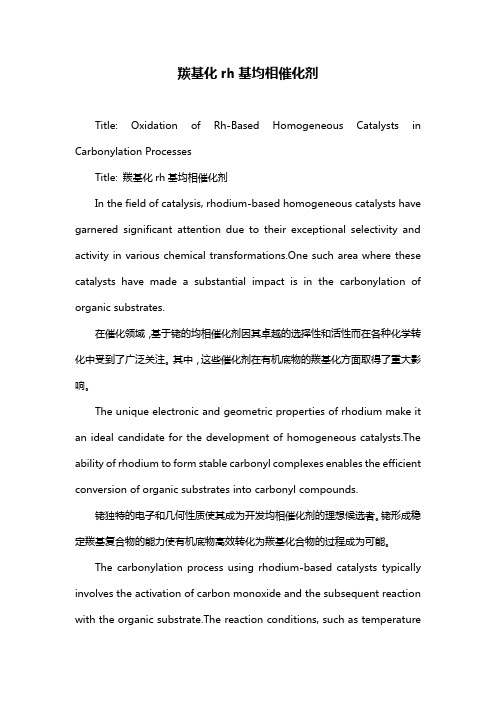
羰基化rh基均相催化剂Title: Oxidation of Rh-Based Homogeneous Catalysts in Carbonylation ProcessesTitle: 羰基化rh基均相催化剂In the field of catalysis, rhodium-based homogeneous catalysts have garnered significant attention due to their exceptional selectivity and activity in various chemical transformations.One such area where these catalysts have made a substantial impact is in the carbonylation of organic substrates.在催化领域,基于铑的均相催化剂因其卓越的选择性和活性而在各种化学转化中受到了广泛关注。
其中,这些催化剂在有机底物的羰基化方面取得了重大影响。
The unique electronic and geometric properties of rhodium make it an ideal candidate for the development of homogeneous catalysts.The ability of rhodium to form stable carbonyl complexes enables the efficient conversion of organic substrates into carbonyl compounds.铑独特的电子和几何性质使其成为开发均相催化剂的理想候选者。
铑形成稳定羰基复合物的能力使有机底物高效转化为羰基化合物的过程成为可能。
The carbonylation process using rhodium-based catalysts typically involves the activation of carbon monoxide and the subsequent reaction with the organic substrate.The reaction conditions, such as temperatureand pressure, as well as the choice of solvent, play a crucial role in determining the outcome of the carbonylation reaction.使用铑基催化剂的羰基化过程通常涉及一氧化碳的活化以及随后与有机底物的反应。
化学反应的选择性催化剂实验研究不同催化剂对化学反应选择性的影响
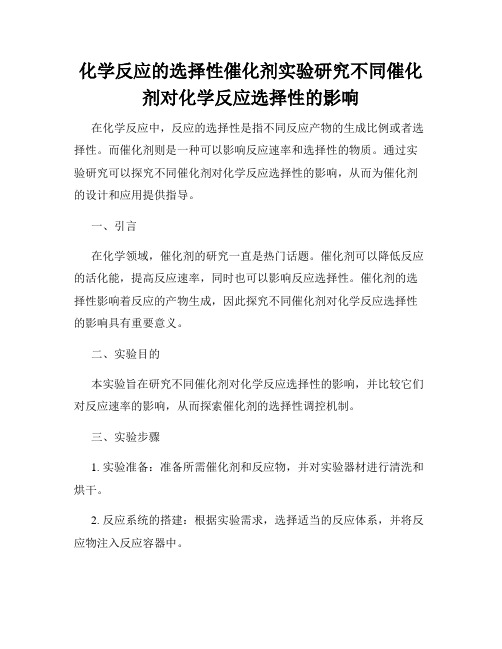
化学反应的选择性催化剂实验研究不同催化剂对化学反应选择性的影响在化学反应中,反应的选择性是指不同反应产物的生成比例或者选择性。
而催化剂则是一种可以影响反应速率和选择性的物质。
通过实验研究可以探究不同催化剂对化学反应选择性的影响,从而为催化剂的设计和应用提供指导。
一、引言在化学领域,催化剂的研究一直是热门话题。
催化剂可以降低反应的活化能,提高反应速率,同时也可以影响反应选择性。
催化剂的选择性影响着反应的产物生成,因此探究不同催化剂对化学反应选择性的影响具有重要意义。
二、实验目的本实验旨在研究不同催化剂对化学反应选择性的影响,并比较它们对反应速率的影响,从而探索催化剂的选择性调控机制。
三、实验步骤1. 实验准备:准备所需催化剂和反应物,并对实验器材进行清洗和烘干。
2. 反应系统的搭建:根据实验需求,选择适当的反应体系,并将反应物注入反应容器中。
3. 催化剂添加:依次向反应体系中添加不同催化剂,并注意记录添加的顺序和量。
4. 反应进行和观察:在适当的反应条件下进行反应,记录反应过程中产物的生成情况和颜色的变化等观察结果。
5. 数据分析:根据实验结果,比较不同催化剂对反应选择性的影响,并分析反应速率的差异。
四、实验结果与讨论根据实验观察结果,在不同催化剂的存在下,反应体系中产物的生成比例或者种类可能会有所变化。
通过实验数据的分析,可以得出不同催化剂对选择性的影响程度,从而为催化剂的设计以及反应体系的优化提供一定的参考。
五、结论通过实验研究,我们得出了不同催化剂对化学反应选择性的影响。
这些结果对于催化剂的应用和反应控制有着重要意义。
催化剂的选择性调控机制可以通过合适的催化剂选择和反应条件控制来实现。
六、展望本实验只对不同催化剂对选择性的影响进行了初步研究,还可以进一步探究不同催化剂的作用机理,并对催化剂进行更加细致的设计和优化,以实现更高的选择性和更高的反应速率。
七、参考文献[1] Smith J, et al. (2017). Selectivity control in catalysis by immobilization of organocatalysts on solid supports. Catalysis Today, 281, 181-192.[2] Li Y, et al. (2018). Influence of catalyst morphology on selectivities of C2 oxygenates from CO hydrogenation. Journal of Catalysis, 360, 245-252.[3] Wang H, et al. (2019). Selectivity control in catalysis using mixed reactants. Nature Catalysis, 2, 138-144.[4] Zhang S, et al. (2020). Rational Design of Cobalt-Free Oxide-Derived Catalysts for Efficient Oxygen Evolution Reaction via Photoelectrochemical Activity Screening, ACS Energy Letters, 87-93.本文综述了催化剂对化学反应选择性的影响,并提供了实验研究的一般步骤和方法。
python catalyst库用法 -回复

python catalyst库用法-回复Python Catalyst 库用法详解【什么是Catalyst库?】Catalyst是一个用于深度学习和强化学习的Python库,其主要特点是高效、灵活和易于使用。
它提供了一个丰富的工具箱,可以用来构建、训练和测试各种机器学习模型。
Catalyst库还包含了许多预定义的模型架构和损失函数,以及用于数据预处理和增强等功能。
在本文中,我们将逐步探讨Catalyst库的用法,帮助读者更好地了解和应用该库。
【安装Catalyst库】要使用Catalyst库,首先需要安装它。
可以使用pip命令在终端或命令行中安装Catalyst库。
具体操作步骤如下:pip install catalyst【使用Catalyst库】安装完成后,我们可以开始使用Catalyst库来构建机器学习模型。
下面将引导您一步一步了解Catalyst库的用法。
步骤1: 导入必要的库和模块首先,我们需要导入Catalyst库和其他必要的Python库和模块。
可以按照以下示例代码导入Catalyst库和其他库:pythonimport torchfrom torch import nnfrom torch.optim import Adamfrom torch.utils.data import DataLoaderfrom torchvision.datasets import MNISTfrom torchvision.transforms import ToTensorfrom catalyst import dl步骤2: 定义模型定义机器学习模型是使用Catalyst库的第一步。
可以使用torch.nn 模块中的各种类来构建模型。
下面是一个使用Catalyst库构建的简单的卷积神经网络(CNN)模型的示例:pythonclass SimpleCNN(nn.Module):def __init__(self):super(SimpleCNN, self).__init__()self.conv1 = nn.Conv2d(1, 16, kernel_size=3, padding=1)self.pool = nn.MaxPool2d(2)self.flatten = nn.Flatten()self.fc1 = nn.Linear(16*14*14, 10)def forward(self, x):x = self.conv1(x)x = self.pool(x)x = self.flatten(x)x = self.fc1(x)return xmodel = SimpleCNN()步骤3: 准备数据在使用Catalyst库之前,我们需要准备训练和测试数据。
黄金内存Guide
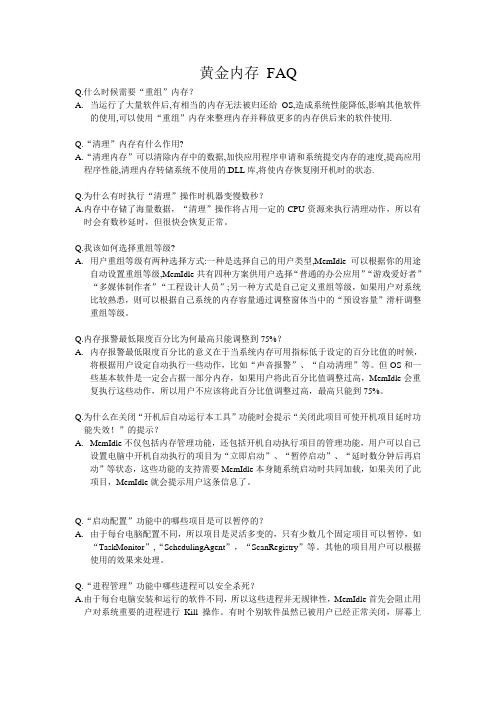
黄金内存FAQQ.什么时候需要“重组”内存?A.当运行了大量软件后,有相当的内存无法被归还给OS,造成系统性能降低,影响其他软件的使用,可以使用“重组”内存来整理内存并释放更多的内存供后来的软件使用.Q.“清理”内存有什么作用?A.“清理内存”可以清除内存中的数据,加快应用程序申请和系统提交内存的速度,提高应用程序性能,清理内存转储系统不使用的.DLL库,将使内存恢复刚开机时的状态.Q.为什么有时执行“清理”操作时机器变慢数秒?A.内存中存储了海量数据,“清理”操作将占用一定的CPU资源来执行清理动作,所以有时会有数秒延时,但很快会恢复正常。
Q.我该如何选择重组等级?A.用户重组等级有两种选择方式:一种是选择自己的用户类型,MemIdle可以根据你的用途自动设置重组等级,MemIdle共有四种方案供用户选择“普通的办公应用”“游戏爱好者”“多媒体制作者”“工程设计人员”;另一种方式是自己定义重组等级,如果用户对系统比较熟悉,则可以根据自己系统的内存容量通过调整窗体当中的“预设容量”滑杆调整重组等级。
Q.内存报警最低限度百分比为何最高只能调整到75%?A.内存报警最低限度百分比的意义在于当系统内存可用指标低于设定的百分比值的时候,将根据用户设定自动执行一些动作,比如“声音报警”、“自动清理”等。
但OS和一些基本软件是一定会占据一部分内存,如果用户将此百分比值调整过高,MemIdle会重复执行这些动作,所以用户不应该将此百分比值调整过高,最高只能到75%。
Q.为什么在关闭“开机后自动运行本工具”功能时会提示“关闭此项目可使开机项目延时功能失效!”的提示?A.MemIdle不仅包括内存管理功能,还包括开机自动执行项目的管理功能,用户可以自已设置电脑中开机自动执行的项目为“立即启动”、“暂停启动”、“延时数分钟后再启动”等状态,这些功能的支持需要MemIdle本身随系统启动时共同加载,如果关闭了此项目,MemIdle就会提示用户这条信息了。
- 1、下载文档前请自行甄别文档内容的完整性,平台不提供额外的编辑、内容补充、找答案等附加服务。
- 2、"仅部分预览"的文档,不可在线预览部分如存在完整性等问题,可反馈申请退款(可完整预览的文档不适用该条件!)。
- 3、如文档侵犯您的权益,请联系客服反馈,我们会尽快为您处理(人工客服工作时间:9:00-18:30)。
1. Introduction The Grubbs’ olefin metathesis catalysts have proven to be invaluable in small molecule synthesis for their ability to catalyze ring closing metathesis reactions and to bond two molecules together through cross metathesis [1]. These catalysts are notable as they are stable to many different functional groups and solvents while the second generation catalyst is as active as the Schrock metathesis catalyst [2]. Recently, new reactions beyond metathesis have been discovered that are catalyzed by the Grubbs’ catalysts that open up new synthetic transformations. Examples of these new reactions include olefin isomerization, deprotection of tertiary amines, isomerization of allylic alcohols to ketones, Kharasch reaction, and hydrosilylation of carbonyls [3–
5279
In this article, we report two important advances with Grubbs’ metathesis catalysts. First, we describe a method that allows one to decide whether to react substrates by olefin metathesis or isomerization with the Grubbs’ catalysts. Second, we report a method to make the Grubbs’ first generation catalyst an isomerization catalyst for a wide range of substrates. These methods increase the number and types of products that can be synthesized with the Grubbs’ catalysts and add another level of control to how they react. This work is built on our prior efforts to occlude the Grubbs’ catalysts in a cross-linked, hydrophobic membrane of polydimethylsiloxane (PDMS) [19]. Catalysts are swelled into mm-sized PDMS slabs with methylene chloride that is removed under vacuum to yield occluded catalysts. PDMS is a new ‘‘solvent’’ for the catalysts that is both apolar and very viscous [20]. To react, reagents diffuse from an aqueous solvent into PDMS, react with the catalyst, and then the product diffuses from PDMS back to the solvent. Occluding catalysts in PDMS membranes has an important impact on how they react and introduced new selectivities and reactivities to mature catalysts. During our work, we discovered that although many substrates react by metathesis with occluded Grubbs’ catalysts, some substrates reacted by olefin isomerization with occluded catalysts (Fig. 1). Interestingly, substrates that reacted by isomerization with occluded catalysts also reacted by metathesis with freely dissolved Grubbs’ catalyst in methylene chloride. This difference in products was very interesting as it made it possible to choose whether to react a substrate by metathesis or isomerization. We extended this work to develop a general olefin isomerization catalyst from the Grubbs’ first generation catalyst that reacts with a wide range of substrates. In this article, we will report which reagents react by olefin isomerization with occluded catalysts but still react by metathesis with freely dissolved catalysts in methylene chloride. In addition, we will describe how heating the Grubbs’ first generation catalyst caused it to become a general isomerization catalyst.
Journal of Organometallic Chemistry 691 (2006) 5278–5288 /locate/jorganchem
New selectivities from old catalysts. Occlusion of Grubbs’ catalysts in PDMS to change their reactions
*
Corresponding author. Tel.: +1 319 335 1198; fax: +1 319 335 1270. E-mail address: ned-bowden@ (N.B. Bowden).
16]. One prominent example of a new reaction catalyzed by the Grubbs’ catalysts is its transformation into an olefin isomerization catalyst. Many examples of these isomerization reactions are for only a select range of substrates with an olefin allylic to an amide, ether, or alcohol [6,8,12,14,15,17]. In other work, transformation of the Grubbs’ catalyst into an olefin isomerization catalyst is more general but requires heat or the addition of H2 or alkoxides [3,12,18]. In many of these prior examples, olefin isomerization was in competition with olefin metathesis and a complex mixture of products was observed. In one report, isomerization was favored when a silyl enol ether was added to the reaction mixture, and in other reports the ratio of isomerization to metathesis product was affected by the choice of solvent or other additives [6,8,12,14,15,17]. The exact mechanism for isomerization is unknown, but it is believed to proceed through a ruthenium hydride that forms during the course of the reaction.
